Rocketing fuel costs and net-zero targets are leading more businesses to seek out connected energy management solutions.
IoT News caught up with Yury Brunt, Team Leader of Manufacturing Analytics at AVEVA Select Benelux, to discuss how the company is helping businesses to manage their energy usage.
IoT News: Amid rocketing energy costs, are you finding that enterprises are showing an increased interest in monitoring their usage?
Yury Bunt: Yes, over the last two years we enabled a dozen of customers with energy analytics. This was one of the major reasons we developed our EMS solution.
IN: How long does it take to integrate AVEVA’s EMS?
YB: When the data is uploaded to the system, our EMS can be up and running within 5 days.
IN: Do you believe an EMS is key to helping businesses achieve their sustainability goals?
YB: There is a need to reduce global emissions on the road to net-zero. Many industrial companies are still struggling with having insight into their energy consumption. People are not enabled to make real improvements in energy-saving or CO2 reduction.
IN: How are digital twins helping to improve the visualisation of manufacturing analytics?
David Ariens, Manager of Project Support at AVEVA: When talking about digital twins, many people only think about 3D models. We believe that these models are just one part of the “digital twin”.
As a first step, we recommend building asset structures into all applications. Moving away from non-understandable engineering definitions such as “F1001A.PV” and towards “Reactor 1 – Outgoing flow” is not only beneficial because it helps the daily user, it also helps the data scientist or the analytics machine learning model to better understand the actual process.
IN: What kind of improvements can an enterprise make based on the insights provided by your manufacturing analytics solution?
YB: Improvement always comes down to better, faster, or cheaper production. Examples could be the optimisation of the amount of moisture in products or capacity analytics showing room for optimisation and preventing companies from having to invest in new equipment.
IN: How does the onboarding process work to ensure your solution works for the customer?
YB: From a project point-of-view, we always work use-case driven. Customers always need to provide us with a proper use-case/business case before we can start on a project.
Common questions are: What information is requested? What is the goal of the project? What data is available for analysis? What is expected as a result?
Yury and the AVEVA team will be sharing their invaluable insights at this year’s AI & Big Data Expo. Find out about Yury’s keynote presentation here and swing by AVEVA’s booth at stand #445.
Tags: aveva, ems, energy management solution, IIoT, internet of things, IoT, TechEx, yury brunt



